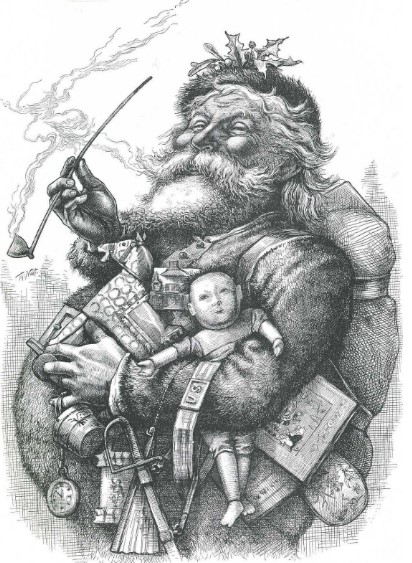Santa Claus is More Than Just a Gift Giver

One of the first renditions of what Santa Claus would look like by Thomas Nast. creating the foundation of what Santa Claus looks like today.
Every year, in the month of December, a plump, snow white bearded man with rosy cheeks goes around the world spreading presents to all of the good boys and girls. This is the Santa Claus that many see, even though his annual worldwide gifting is only the surface of his history and what he represents.
Santa Claus himself isn’t an actual person per say; nor does he go to millions of houses overnight delivering presents.
“He represents an idea of what everybody should aspire to be around Christmas time,” said Logan Lally. “Parents really apply the whole Santa Claus deal, so they can behave more around that time of the year.” However, Santa Claus isn’t just an idea for parents to use to get their children to behave.
“He’s like a mascot of the holiday, like how the Easter Bunny represents Easter or how Halloween is usually represented with pumpkins,” said Dezerenee Lally.
Being one of the main persons that coincides with the holiday, his image and message helps set the foundation of what the month of December is to be celebrated for.
“Christmas is a time where people can meet each other on even ground and have a reason to come together and spend time together. Whether it be through giving a present to a coworker or eating dinner with family, or just enjoying the cold weather with some friends on a call,” said Ma Reichelle Pizarro
The idea of Claus is based on a real person who had lived a long time ago, a bishop known as Saint Nicholas, who lived in Myra and dedicated much of his fortune to his local church and the less fortunate.
Over the course of his entire life, he was known to have been greatly generous to the many people around him. Especially so with children, having said to give them gifts regularly.
While in Myra, he would load the port’s ships with gifts and goods for the needy, which would then travel all around the Mediterranean world. Sailors spread the good world of Nicholas with them, which became quite legendary. In the sixth century, a church was dedicated to him in Constantinople.
His legend spread toward Germany, bringing up the tradition of giving gifts to each other in the name of Nicholas; as well in the Netherlands. The celebrations would take place on Dec 6, which is thought to be the day he died. The Dutch name for him was Sinterklaas, though eventually the German word became the man we all know and love Claus.
The tradition would eventually be adapted into a Protestant alternative to the Roman Catholic practice, where instead of giving gifts in the name of Claus in December they would give gifts in the name of the Christ child. The Tradition of Christmas has been fixed on December the 25th, the birth of Jesus Christ. The word Christmas comes from the word Christ Mass.
Santa Claus isn’t a giver; he is an ideal. Helping make what Christmas is today and spreading the love of giving, and his image will continue to do so till the end of time.


